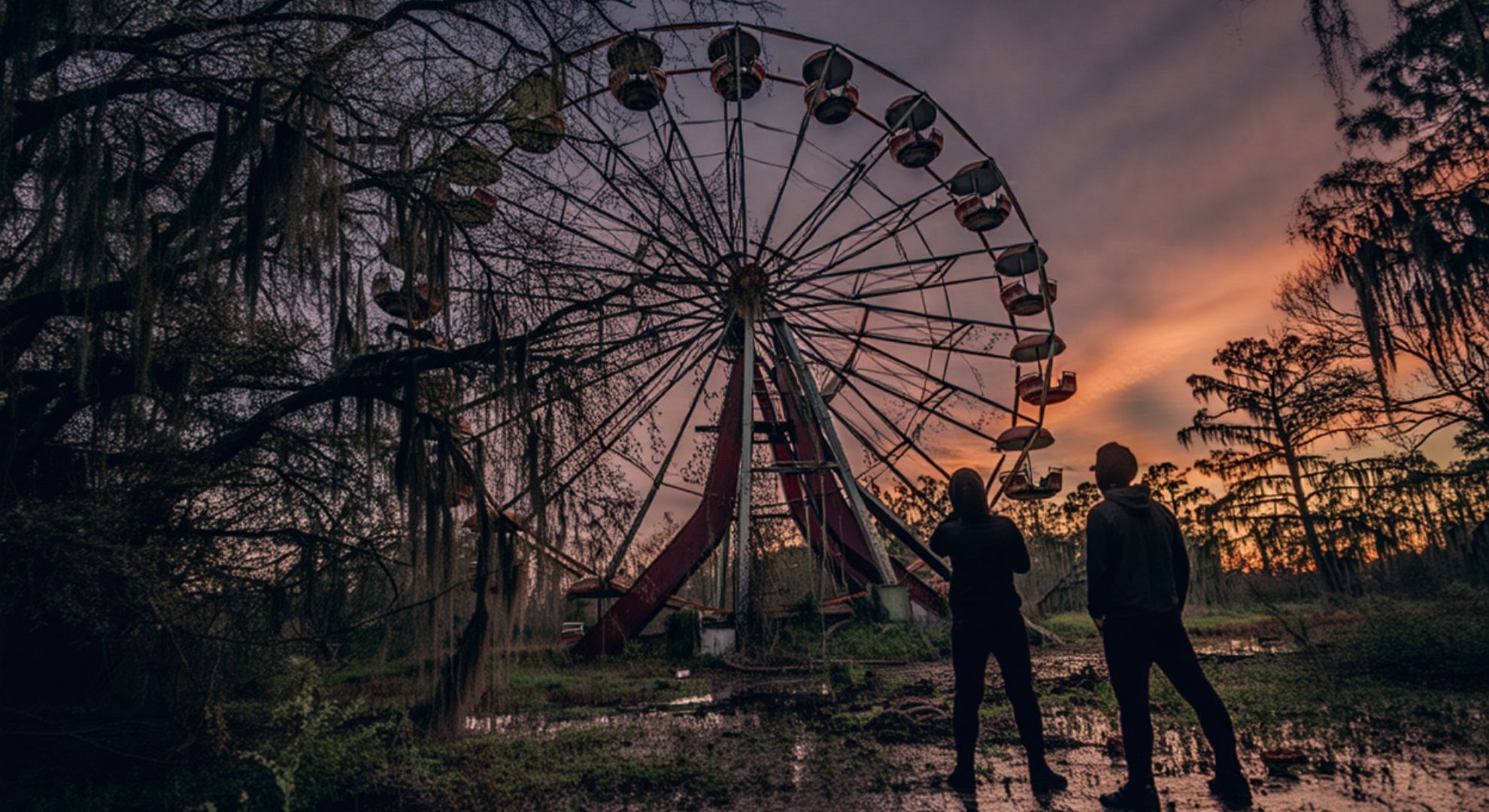The gates are chained, the lights are dark, and the laughter is gone, yet the air still holds a charge, a faint echo of summer joy. In this Louisiana relic, time feels waterlogged, memory feels salted. What remains is a theater of rust and reed, a slow-motion palimpsest where the Gulf’s weather keeps rewriting the script.
Here, the wind has a repertoire, whistling through steel, sifting through sugar sand, stirring a carousel of scents: wet wood, hot metal, marshy grass. Every sound is a footnote, every puddle a mirror.
A drowned carnival of memory
Long after the rides fell silent, the place became a textbook of disaster’s afterlife. Floodwater etched seams into concrete, paint peeled like sunburn. The roller coasters stand as skeletal horizons, their loops clasping humid sky. What was once a map of delight is now a delta of decay, navigated by egrets, ivy, and the occasional camera, held in gloved hands.
Locals tell a story that changes with the tide, equal parts grief and grit. The city’s development dreams circle like kites, held by fraying string. Nothing is ever fully closed, nothing ever fully open.
Why explorers keep coming
Urban explorers chase the threshold, that thin line between ruin and resurrection. This park offers a theater of contrasts: bright signage gone ghost, kid-sized joy turned colossus of metal and moss. “It’s where the American fairytale meets the American flood,” says one aficionado, “and both are true, both are loud.”
There’s the photographic draw—those clean, vanishing lines of track, the Ferris wheel’s geometry, the pastel stubbornness of a food stand. There’s also the cultural pull: a reminder that fun is infrastructure, and infrastructure is fragile.
What remains behind the fences
You’ll find the alphabet of a vanished midway: prizes without winners, booths without voices. Vines braid handrails, wasps claim corners. The place is not empty; it is busy with weather, wildlife, and memory. The South knows how to haunt, and this park is a devotional to stubbornness.
A caution beats beneath the allure. The ground is unpredictable, structures are tired, and the law is clear: trespass is trespass, even when the carousel is quiet.
How it compares to other ruins
Below is a simple snapshot of similar sites, placing this Louisiana park in a broader context of post-funfair afterlives.
| Site | Location | Year abandoned | Signature sight | Risk level | Access status |
|---|---|---|---|---|---|
| New Orleans park | Louisiana, USA | 2005 | Sun-bleached coasters, flooded midways | High | Restricted, no public access |
| Spreepark | Berlin, Germany | 2002 | Swan boats, toppled dinosaur | Medium | Limited, guided events at times |
| Pripyat park | Ukraine | 1986 | Ferris wheel over empty square | High | Restricted, tours historically required |
Comparisons reveal a pattern: parks become symbols after they stop operating. In each case, the rides grow quieter, while the meaning grows louder.
Ethics and safety
The line between documentation and damage is thin. Responsible engagement means centering community, legality, and safety, not adrenaline or status.
- Choose legal routes, support guided access where possible, and remember that ruins belong to a larger ecosystem, including neighbors, wildlife, and workers.
Think of exploration as a conversation, not a trophy. Ask what the place wants to teach, not what it can give you.
Voices from the margins
“I come here for the silences, the way rust makes music,” says a photographer, describing the park as a kind of open-air archive, a humid museum of mistakes. Another visitor reflects: “It’s a mirror for cities—how we build for joy, and how we forget to rebuild it when the weather turns mean.”
These statements aren’t about danger, or conquest; they’re about the grammar of place, how loss punctuates a sentence, and how a city tries to rewrite its ending.
The pull of the American South
What keeps this place in the imagination is the way it fuses myth and mud. The Gulf breeds stories, and the midway was always a story machine. Now the rides tell a different tale, one of entropy, equity, and exposure—who gets rescued, who gets rebuilt, who gets remembered.
Look long enough and you’ll see two timelines braided together: one where kids eat cotton candy under July sun, and one where cranes and egrets balance on a handrail, both waiting for a better forecast. The park holds both histories, and the city lives in that tension.
In the end, the lure isn’t just the ruin, but the reckoning. This is a classroom with thunderheads, a cautionary ferris wheel that turns even while it stands still. And the lesson, like the humidity, refuses to lift.


💔